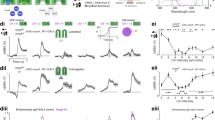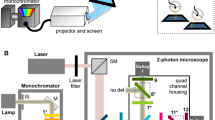Abstract
To extract the third dimension from a two-dimensional retinal image most insects, including bees, cannot rely on mechanisms common in vertebrates such as accommodation, binocular convergence or stereoscopic vision1,2. Instead, they use the apparent size of familiar objects (the nearer the object, the larger its image), and objects' apparent motion (the nearer an object, the higher the speed of its image) 3–8. In several studies9–12 bees have been found to exploit size cues, whereas in others6,11,13 they seem to use both strategies. We have studied the influence of motion cues in isolation by excluding size cues. We report that bees can discriminate between objects at different distances irrespective of their size. This discrimination is mediated primarily by the green-sensitive visual channel and is therefore colour blind, like all of the motion-dependent behaviours investigated so far in the bee14–17. The bee's ability to discriminate range by motion of the image explains how bees manage to manoeuvre in novel environments, where the size of objects is unknown.
This is a preview of subscription content, access via your institution
Access options
Subscribe to this journal
Receive 51 print issues and online access
$199.00 per year
only $3.90 per issue
Buy this article
- Purchase on Springer Link
- Instant access to full article PDF
Prices may be subject to local taxes which are calculated during checkout
Similar content being viewed by others
References
Horridge, G. A. Endeavour 1, 7–17 (1977).
Collett, T. S. & Harkness, L. I. K. in Analysis of Visual Behaviour (eds Ingle, D. J., Goodale, M. A. & Mansfield, R. J. W.) 111–176 (MIT Press, Cambridge, 1982).
Gibson, E. J., Gibson, J. J. & Smith, O. W. J. exp. Psychol. 58, 40–51 (1959).
Wallace, G. K. J. exp. Biol. 36, 512–525 (1959).
Collett, T. S. J. exp. Biol. 76, 237–241 (1978).
Cartwright, B. A. & Collett, T. S. J. exp. Biol. 82, 367–372 (1979).
Erikson, E. S. J. exp. Biol. 86, 337–340 (1980).
Horridge, G. A. Proc. R. Soc. Lond. B229, 23–27 (1986).
Lauer, J. & Lindauer, M. Informationsaufnahme und Informationsbearbeitung im lebenden Organismus Vol. 1, 1–87 (Steiner, Wiesbaden, 1971).
Maurer, B. thesis, Univ. Zurich (1980).
Lehrer, M. thesis, Univ. Zurich (1980).
Cartwright, B. A. & Collett, T. S. J. comp. Physiol. 151, 521–543 (1983).
Cheng, K., Collett, T. S., Pickhard, A. & Wehner, R. J. comp. Physiol. 161, 469–475 (1987).
Kaiser, W. & Liske, E. J. J. comp. Physiol. 89, 391–408 (1974).
Srinivasan, M. V. & Lehrer, M. J. comp. Physiol. 155, 297–312 (1984).
Lehrer, M., Wehner, R. & Srinivsan, M. V. J. comp. Physiol. 157, 405–415 (1985).
Srinivasan, M. V. & Lehrer, M. J. comp. Physiol. 162, 159–172 (1988).
Erber, J. J. comp. Physiol. 146, 273–282 (1982).
Author information
Authors and Affiliations
Rights and permissions
About this article
Cite this article
Lehrer, M., Srinivasan, M., Zhang, S. et al. Motion cues provide the bee's visual world with a third dimension. Nature 332, 356–357 (1988). https://doi.org/10.1038/332356a0
Received:
Accepted:
Issue Date:
DOI: https://doi.org/10.1038/332356a0
This article is cited by
-
Optic flow based spatial vision in insects
Journal of Comparative Physiology A (2023)
-
Motion cues from the background influence associative color learning of honey bees in a virtual-reality scenario
Scientific Reports (2021)
-
Color discrimination and preference in the fire ant Solenopsis invicta Buren
Insectes Sociaux (2020)
-
Multispectral images of flowers reveal the adaptive significance of using long-wavelength-sensitive receptors for edge detection in bees
Journal of Comparative Physiology A (2017)
-
Vergleichende Betrachtung von Lichtempfindlichkeit, Tiefenwahrnehmung und Bewegungswahrnehmung bei Tier und Mensch
Der Ophthalmologe (2017)
Comments
By submitting a comment you agree to abide by our Terms and Community Guidelines. If you find something abusive or that does not comply with our terms or guidelines please flag it as inappropriate.



